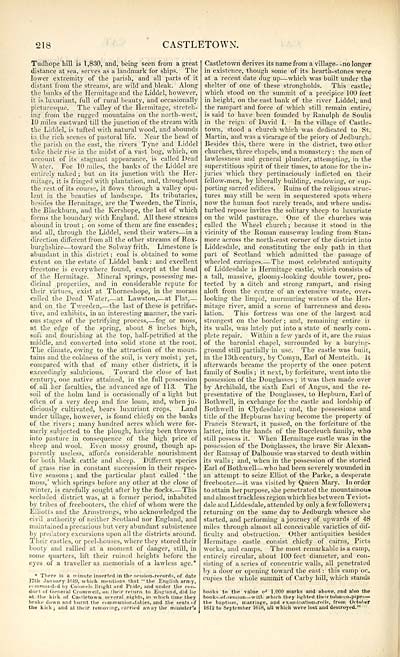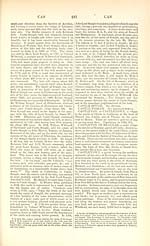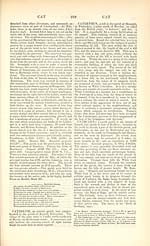Topographical, statistical, and historical gazetteer of Scotland > Volume 1
(298) Page 218
Download files
Complete book:
Individual page:
Thumbnail gallery: Grid view | List view

218
CASTLETOWN.
Tudhope hill is 1,830, and, being seen from a great
distance at sea, serves as a landmark for ships. The
lower extremity of the parish, and all parts of it
distant from the streams, are wild and bleak. Along
the banks of the Hermitage and the Liddel, however,
it is luxuriant, full of rural beauty, and occasionally
picturesque. The valley of the Hermitage, stretch-
ing from the rugged mountains on the north-west,
10 miles eastward till the junction of the stream with
the Liddel, is tufted with natural wood, and abounds
in the rich scenes of pastoral life. Near the head of
the parish on the east, the rivers Tyne and Liddel
take their rise in the midst of a vast bog, which, on
account of its stagnant appearance, is called Dead
Water. For 10 miles, the banks of the Liddel are
entirely naked ; but on its junction with the Her-
mitage, it is fringed with plantation, and, throughout
the rest of its course, it flows through a valley opu-
lent in the beauties of landscape. Its tributaries,
besides the Hermitage, are the Tweeden, the Tinnis,
the Blackburn, and the Kershope, the last of which
forms the boundary with England. All these streams
abound in trout ; on some of them are fine cascades ;
and all, through the Liddel, send their waters — in a
direction different from all the other streams of Rox-
burghshire — toward the Sol way frith. Limestone is
abundant in this district ; coal is obtained to some
extent on the estate of Liddel bank : and excellent
freestone is everywhere found, except at the head
of the Hermitage. Mineral springs, possessing me-
dicinal properties, and in considerable repute for
their virtues, exist at Thorneshope, in the morass
called the Dead Water, — at Lawston, — at Flat, —
and on the Tweeden, — the last of these is petrifac-
tive, and exhibits, in an interesting manner, the vari-
ous stages of the petrifying process, — fog or moss,
at the edge of the spring, about 8 inches high,
soft and flourishing at the top, half-petrified at the
middle, and converted into solid stone at the root.
The climate, owing to the attraction of the moun-
tains and the coldness of the soil, is very moist ; yet,
compared with that of many other districts, it is
exceedingly salubrious. Toward the close of last
century, one native attained, in the full possession
of all her faculties, the advanced age of 113. The
soil of the holm land is occasionally of a light but
often of a very deep and fine loam, and, when ju-
diciously cultivated, bears luxuriant crops. Land
under tillage, however, is found chiefly on the banks
of the rivers ; many hundred acres which were for-
merly subjected to the plough, having been thrown
into pasture in consequence of the high price of
sheep and wool. Even mossy ground, though ap-
parently useless, affords considerable nourishment
for both black cattle and sheep. Different species
of grass rise in constant succession in their respec-
tive seasons ; and the particular plant called ' the
moss,' which springs before any other at the close of
winter, is carefully sought after by the flocks This
secluded district was, at a former period, inhabited
by tribes of freebooters, the chief of whom were the
Elliotts and the Armstrongs, who acknowledged the
civil authority of neither Scotland nor England, and
maintained a precarious but very abundant subsistence
by predatory excursions upon all the districts around.
Their castles, or peel-houses, where they stored their
booty and rallied at a moment of danger, still, in
some quarters, lift their ruined heights before the
eyes of a traveller as memorials of a lawless age.*
* There is a minute inserted in the session-records, of date
17tli January Kf-19, which mentions that "the English array,
e'linmaiidt d by Colonels Bright and Pride, and under the eim-
dnet of General Cromwell, on their return to England, did lie
at Ihe kirk of Castletown several nights, inwhich time they
brake down and burnt the communion-tables, and the seatB of
the kiik; and at their removing, tarried away the minister's
Castletown derives its name from a village- -no longer
in existence, though some of its hearth-stones were
at a recent date dug up — which was built under the
shelter of one of these strongholds. This castle,
which stood on the summit of a precipice 100 feet
in height, on the east bank of the river Liddel, and
the rampart and force of which still remain entire,
is said to have been founded by Ranulph de Soulis
in the reign of David I. In the village of Castle-
town, stood a church which was dedicated to St.
Martin, and was a vicarage of the priory of Jedburgh.
Besides this, there were in the district, two other
churches, three chapels, and a monastery : the men of
lawlessness and general plunder, attempting, in the
superstitious spirit of their times, to atone for the in-
juries which they pertinaciously inflicted on their
fellow-men, by liberally building, endowing, or sup-
porting sacred edifices. Ruins of the religious struc-
tures may still be seen in sequestered spots where
now the human foot rarely treads, and where undis-
turbed repose invites the solitary sheep to luxuriate
on the wild pasturage. One of the churches was
called the Wheel church; because it stood in the
vicinity of the Roman causeway leading from Stan-
more across the north-east corner of the district into
Liddesdale, and constituting the only path in that
part of Scotland which admitted the passage of
wheeled carriages. — The most celebrated antiquity
of Liddesdale is Hermitage castle, which consists of
a tall, massive, gloomy-looking double tower, pro-
tected by a ditch and strong rampart, and rising
aloft from the centre of an extensive waste, over-
looking the limpid, murmuring waters of the Her-
mitage river, amid a scene of barrenness and deso-
lation. This fortress M'as one of the largest and
strongest on the border ; and, remaining entire h
its walls, was lately put into a state of nearly com-
plete repair. Within a few yards of it, are the ruins
of the baronial chapel, surrounded by a burying-
ground still partially in use. The castle was built,
in the 1 3th century, by Comyn, Earl of Menteith. It
afterwards became the property of the once potent
family of Soulis ; it next, by forfeiture, went into the
possession of the Douglasses ; it was then made over
by Archibald, the sixth Earl of Angus, and the re-
presentative of the Douglasses, to Hepburn, Earl of
Bothwell, in exchange for the castle and lordship of
Bothwell in Clydesdale ; and, the possessions and
title of the Hepburns having become the property of
Francis Stewart, it passed, on the forfeiture of the
latter, into the hands of the Buccleuch family, who
still possess it. When Hermitage castle was in the
possession of the Douglasses, the brave Sir Alexan-
der Ramsay of Dalhousie was starved to death within
its walls ; and, when in the possession of the storied
Earl of Bothwell — who had been severely wounded in
an attempt to seize Elliot of the Parke, a desperate
freebooter — it was visited by Queen Mary. In order
to attain her purpose, she penetrated the mountainous
and almost trackless region which lies between Teviot-
dale and Liddesdale, attended by only a few followers ;
returning on the same day to Jedburgh whence she
started, and performing a journey of upwards of 48
miles through almost all conceivable varieties of dif-
ficulty and obstruction. Other antiquities besides
Hermitage castle consist chiefly of cairns, Picts
works, and camps. The most remarkable is a camp,
entirely circular, about 100 feet diameter, and con-
sisting of a series of concentric walls, all penetrated
by a door or opening toward the east : this camp oc.
cupies the whole summit of Carby hill, which stands
books to the value o f 1.000 marks and above, 2nd also the
books-of-session — with which they lighted their tobacco-pipes —
the baptism, marriage, and examination- rolls, front October
1612 to September 1618, all which were lost and destroyed.**
CASTLETOWN.
Tudhope hill is 1,830, and, being seen from a great
distance at sea, serves as a landmark for ships. The
lower extremity of the parish, and all parts of it
distant from the streams, are wild and bleak. Along
the banks of the Hermitage and the Liddel, however,
it is luxuriant, full of rural beauty, and occasionally
picturesque. The valley of the Hermitage, stretch-
ing from the rugged mountains on the north-west,
10 miles eastward till the junction of the stream with
the Liddel, is tufted with natural wood, and abounds
in the rich scenes of pastoral life. Near the head of
the parish on the east, the rivers Tyne and Liddel
take their rise in the midst of a vast bog, which, on
account of its stagnant appearance, is called Dead
Water. For 10 miles, the banks of the Liddel are
entirely naked ; but on its junction with the Her-
mitage, it is fringed with plantation, and, throughout
the rest of its course, it flows through a valley opu-
lent in the beauties of landscape. Its tributaries,
besides the Hermitage, are the Tweeden, the Tinnis,
the Blackburn, and the Kershope, the last of which
forms the boundary with England. All these streams
abound in trout ; on some of them are fine cascades ;
and all, through the Liddel, send their waters — in a
direction different from all the other streams of Rox-
burghshire — toward the Sol way frith. Limestone is
abundant in this district ; coal is obtained to some
extent on the estate of Liddel bank : and excellent
freestone is everywhere found, except at the head
of the Hermitage. Mineral springs, possessing me-
dicinal properties, and in considerable repute for
their virtues, exist at Thorneshope, in the morass
called the Dead Water, — at Lawston, — at Flat, —
and on the Tweeden, — the last of these is petrifac-
tive, and exhibits, in an interesting manner, the vari-
ous stages of the petrifying process, — fog or moss,
at the edge of the spring, about 8 inches high,
soft and flourishing at the top, half-petrified at the
middle, and converted into solid stone at the root.
The climate, owing to the attraction of the moun-
tains and the coldness of the soil, is very moist ; yet,
compared with that of many other districts, it is
exceedingly salubrious. Toward the close of last
century, one native attained, in the full possession
of all her faculties, the advanced age of 113. The
soil of the holm land is occasionally of a light but
often of a very deep and fine loam, and, when ju-
diciously cultivated, bears luxuriant crops. Land
under tillage, however, is found chiefly on the banks
of the rivers ; many hundred acres which were for-
merly subjected to the plough, having been thrown
into pasture in consequence of the high price of
sheep and wool. Even mossy ground, though ap-
parently useless, affords considerable nourishment
for both black cattle and sheep. Different species
of grass rise in constant succession in their respec-
tive seasons ; and the particular plant called ' the
moss,' which springs before any other at the close of
winter, is carefully sought after by the flocks This
secluded district was, at a former period, inhabited
by tribes of freebooters, the chief of whom were the
Elliotts and the Armstrongs, who acknowledged the
civil authority of neither Scotland nor England, and
maintained a precarious but very abundant subsistence
by predatory excursions upon all the districts around.
Their castles, or peel-houses, where they stored their
booty and rallied at a moment of danger, still, in
some quarters, lift their ruined heights before the
eyes of a traveller as memorials of a lawless age.*
* There is a minute inserted in the session-records, of date
17tli January Kf-19, which mentions that "the English array,
e'linmaiidt d by Colonels Bright and Pride, and under the eim-
dnet of General Cromwell, on their return to England, did lie
at Ihe kirk of Castletown several nights, inwhich time they
brake down and burnt the communion-tables, and the seatB of
the kiik; and at their removing, tarried away the minister's
Castletown derives its name from a village- -no longer
in existence, though some of its hearth-stones were
at a recent date dug up — which was built under the
shelter of one of these strongholds. This castle,
which stood on the summit of a precipice 100 feet
in height, on the east bank of the river Liddel, and
the rampart and force of which still remain entire,
is said to have been founded by Ranulph de Soulis
in the reign of David I. In the village of Castle-
town, stood a church which was dedicated to St.
Martin, and was a vicarage of the priory of Jedburgh.
Besides this, there were in the district, two other
churches, three chapels, and a monastery : the men of
lawlessness and general plunder, attempting, in the
superstitious spirit of their times, to atone for the in-
juries which they pertinaciously inflicted on their
fellow-men, by liberally building, endowing, or sup-
porting sacred edifices. Ruins of the religious struc-
tures may still be seen in sequestered spots where
now the human foot rarely treads, and where undis-
turbed repose invites the solitary sheep to luxuriate
on the wild pasturage. One of the churches was
called the Wheel church; because it stood in the
vicinity of the Roman causeway leading from Stan-
more across the north-east corner of the district into
Liddesdale, and constituting the only path in that
part of Scotland which admitted the passage of
wheeled carriages. — The most celebrated antiquity
of Liddesdale is Hermitage castle, which consists of
a tall, massive, gloomy-looking double tower, pro-
tected by a ditch and strong rampart, and rising
aloft from the centre of an extensive waste, over-
looking the limpid, murmuring waters of the Her-
mitage river, amid a scene of barrenness and deso-
lation. This fortress M'as one of the largest and
strongest on the border ; and, remaining entire h
its walls, was lately put into a state of nearly com-
plete repair. Within a few yards of it, are the ruins
of the baronial chapel, surrounded by a burying-
ground still partially in use. The castle was built,
in the 1 3th century, by Comyn, Earl of Menteith. It
afterwards became the property of the once potent
family of Soulis ; it next, by forfeiture, went into the
possession of the Douglasses ; it was then made over
by Archibald, the sixth Earl of Angus, and the re-
presentative of the Douglasses, to Hepburn, Earl of
Bothwell, in exchange for the castle and lordship of
Bothwell in Clydesdale ; and, the possessions and
title of the Hepburns having become the property of
Francis Stewart, it passed, on the forfeiture of the
latter, into the hands of the Buccleuch family, who
still possess it. When Hermitage castle was in the
possession of the Douglasses, the brave Sir Alexan-
der Ramsay of Dalhousie was starved to death within
its walls ; and, when in the possession of the storied
Earl of Bothwell — who had been severely wounded in
an attempt to seize Elliot of the Parke, a desperate
freebooter — it was visited by Queen Mary. In order
to attain her purpose, she penetrated the mountainous
and almost trackless region which lies between Teviot-
dale and Liddesdale, attended by only a few followers ;
returning on the same day to Jedburgh whence she
started, and performing a journey of upwards of 48
miles through almost all conceivable varieties of dif-
ficulty and obstruction. Other antiquities besides
Hermitage castle consist chiefly of cairns, Picts
works, and camps. The most remarkable is a camp,
entirely circular, about 100 feet diameter, and con-
sisting of a series of concentric walls, all penetrated
by a door or opening toward the east : this camp oc.
cupies the whole summit of Carby hill, which stands
books to the value o f 1.000 marks and above, 2nd also the
books-of-session — with which they lighted their tobacco-pipes —
the baptism, marriage, and examination- rolls, front October
1612 to September 1618, all which were lost and destroyed.**
Set display mode to: Large image | Transcription
Images and transcriptions on this page, including medium image downloads, may be used under the Creative Commons Attribution 4.0 International Licence unless otherwise stated. ![]()
| Gazetteers of Scotland, 1803-1901 > Topographical, statistical, and historical gazetteer of Scotland > Volume 1 > (298) Page 218 |
|---|
| Permanent URL | https://digital.nls.uk/97441122 |
|---|
| Description | Volume first. A-H. |
|---|---|
| Attribution and copyright: |
|

